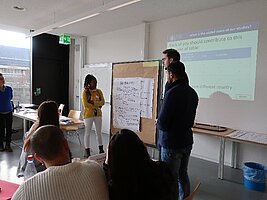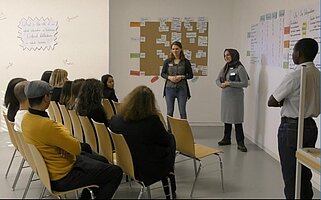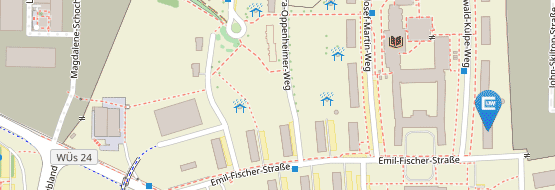Mixed Method Group Presentation


Aim of the strategy/method
The aim is to give first-year undergraduate students an overview and hands-on experience of the most common group presentation methods, which they will need throughout their academic and professional work:
- mind maps
- scientific posters
- panel discussions
- case examples
(Other methods may include ‘devil’s advocate’ discussions, ‘vernissage’-style presentations of results, and many more. Students are required to give different presentations and co-moderate single seminar lessons throughout their studies. All methods focus on small groups presenting prepared materials that the larger group knows nothing about).
Type and name of the course, curriculum, number of students
Introduction to the basic principles of research (1st semester), B.A. Adult Education.
Groups of 4-5 people in a class of 15-20 students.
Description of the strategy/method
- The method was used in 2 consecutive weeks of the course, with one week devoted to preparation and one week to presentations.
Preparation phase (by teacher, approx. 3 hours)
- Topics were selected from the semester’s lecture (here: AE participation, lifelong learning concepts, adult learning, educational justice). Students were asked to select two slides from the lecture’s presentation (available online) to serve as a basis for their own presentation.
- Methods that have proven useful to train students’ presentation skills were selected and assigned to a group. A descriptive handout with tasks for the presentation was prepared for each group.
- Topics and tasks were combined into printed handout folders for each group.
Week 1:
- Students were randomly divided into four groups (with 4-5 students each). Every group received their set topic and a presentation method prepared in a group-specific printed handout folder and a short overview over the following tasks (10 minutes).
- Each group read through their presentation folder and started researching their topic for this week. Roles and content responsibilities were defined for each group member, and the groups started to work on their presentations. I answered questions and gave explanations on the expected outcome (80 minutes).
- Homework: The groups finished their presentations outside the classroom (unknown time, approx. 1-2 hours).
- Students prepared all their needed materials themselves. Some materials, like pens, poster paper, and a contact at the university printing department, were provided as assistance.
Week 2:
- The groups gave their presentations, with every person having approx. 5 minutes of speaking time (total: 90 minutes).
Materials required
In general:
- classroom
- pre-prepared topics with text (excerpts of 2-3 pages; lecture presentation, ….) for every group
- pre-prepared description of the presentation methods with tasks for every group: mind map, scientific poster, panel discussion, case example.
Materials per group method:
- Mind map: paper cards, markers, adhesive tape and wall / magnets and board
- Scientific poster: flipchart paper and markers (when students print or plot their own poster: nothing)
- Panel discussion: nothing
- Case example: Each student may choose the method to visualize his/her case example (teachers may limit choices), e.g. projector, whiteboard, paper cards / flipchart paper, and markers…
Origin and theoretical framework
Origin:
mix of presentation methods common in adult education courses and everyday scientific work. Strongly related to the practice of adult education outside academia. No specific origin, individual methods are widely used.
Theoretical framework:
Policy level: Presentation skills are part of the so-called ‘soft skills’ (or ‘personal and professional skills’, cf. European Council 2011/C 372/01, p.2), which are commonly encouraged by educational policies, especially in higher education. The shift of skills typically needed in labor market positions, especially for adult educators, include skills in using digital tools for presentations in a didactically productive way.
Teaching and learning: The method is used mostly in the field of media pedagogy. The aim is to enable students (and hence future adult educators) to independently and responsibly use different media in presentation contexts (cf. Dinkelaker, 2018, pp. 124f). From a professional point of view, the method simulates team-based result presentations or professional discussions of scientific results and positions.
Risks and advantages
- Risk: One major weakness of the method is the risk of one or more group members giving insufficient presentations, but this risk applies to all group-based methods.
- Advantage: The biggest advantage is that each student personally experiences one method during their own five-minute presentation while also experiencing the methods used by the other groups from the audience’s point of view. Another advantage is the possibility to include the presentations in the grade students receive for the course/seminar and to divide different topics from a lecture, for example, into smaller group work.
Possible variations
- When first tested, it became clear that the chosen presentation method should match the group’s topic, meaning methods should not be assigned randomly. Some topics go very well with some methods (especially panel discussions), whereas others don’t. The range of presentation methods could be expanded to five or six, depending on course size. Likewise, group size and presentation time per student may be adjusted to fit the needs of the course/seminar. In our case, 5 minutes per person were enough to grade each student’s performance while keeping overall presentation time within reasonable limits (the presentation grade was only a small part of a portfolio grade). Depending on group size and class duration, one more week or class may be needed to hear all presentations.
Other examples where you think it could be used
- Workshops on presentation methods, seminars with presentation requirement.
Recommendations
- The topics of the groups should build on either the previous seminar or a concurrent lecture to achieve a thematic connection.
Annexes- Examples from an University in Germany
Guidelines for creating a mindmap (in german)
Guidlines for a guided panel discussion (in german)
Guidelines for the presentation of a case study (in german)
Guidelines for the presentation of a scientific poster (in german)
References
Council of the European Union. (2011). Council Resolution on a renewed European agenda for adult learning. In: Official Journal of the European Union, C 372/01, URL: https://eur-lex.europa.eu/legal-content/EN/TXT/PDF/?uri=OJ:C:2011:372:FULL&from=EN [2020-06-04].
Dinkelaker, J. (2018). Lernen Erwachsener. Kohlhammer.
Contact Persons
Sabine Schmidt- Lauff (schmidt-lauff@hsu-hh.de)
Jan Schiller (schiller@hsu-hh.de)


